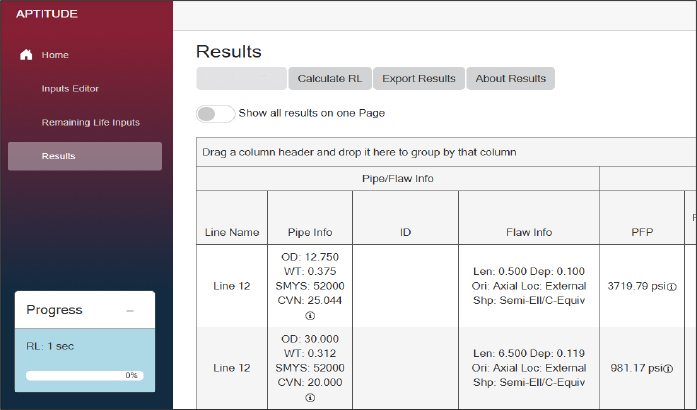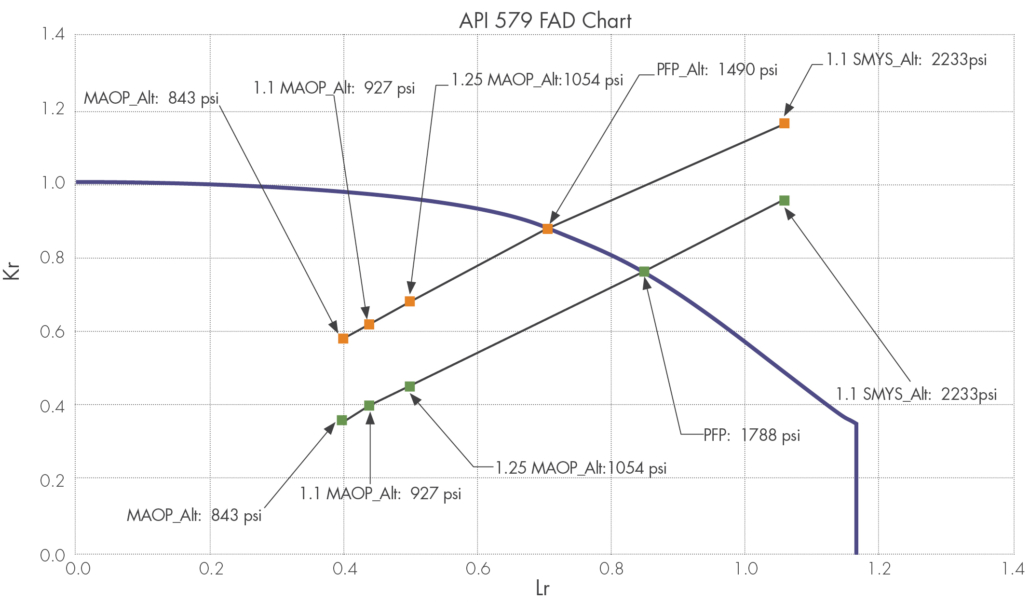News and Views, Volume 55 | Joint Industry Project: APTITUDE Flaw Evaluation Software
By: Scott Riccardella, TJ Prewitt, Tyson Manning and Isaac Smith
Aging pipeline infrastructure and past incidents have driven PHMSA to introduce stricter regulations, requiring operators to conduct rigorous evaluation of flaws identified during inspections. Recognizing these needs, SI developed APTITUDE, an analytical tool for calculating Predicted Failure Pressure (PFP) and determining reassessment intervals per 49 CFR §192.712, §192.933, and §192.714. In 2024, SI convened a joint industry project (JIP) with seven participating operators, upgrading APTITUDE to a web-based platform with enhanced capabilities and accessibility that is available as of March 2025. Later this year, additional features will be introduced, providing further benefits to operators.


Figure 1. Predicted Failure Pressure and Remaining Life Calculation
The integrity of North America’s pipeline infrastructure has been a growing concern, especially following significant incidents that have occurred over the last 15 years. In response, the Pipeline and Hazardous Materials Safety Administration (PHMSA) introduced comprehensive regulations under the Gas Mega Rule, specifically RIN-1 and RIN-2, to enhance pipeline safety and integrity management. These regulations mandate that operators implement rigorous inspection protocols and improved procedures to prevent future incidents. Consequently, operators are now tasked with collecting and managing extensive inspection data, necessitating the adoption of standardized software tools to efficiently analyze findings, prioritize repairs, and ensure compliance with evolving safety standards.
Recognizing this need, SI began developing and using the APTITUDE platform to calculate the Predicted Failure Pressure (PFP) for cracks and crack-like defects identified during pipeline inspections, in accordance with 49 CFR §192.712. APTITUDE also has the capability to evaluate re-assessment intervals and response criteria per the requirements of this section of code as well as §192.933 and §192.714. APTITUDE streamlines the serviceability process through a simplified interface that provides vast capabilities without unnecessary complexity, making it accessible even for users who aren’t subject matter experts.
APTITUDE was originally developed in 2016 as an MS-Excel based tool, which was utilized by pipeline operators to evaluate crack and crack-like defects. A list of APTITUDE features is summarized at the top of the next page. In the years since the original development, SI has observed varying levels of understanding and efficacy in implementing PFP evaluations. In response, SI proposed a 2024 joint industry project (JIP) to upgrade APTITUDE to a cloud-based, web-enabled calculation engine, and to provide a series of training and knowledge-sharing workshops. By standardizing a web-based engine, our teams are able to eliminate installation hassles, ensure seamless updates of new features, and better support collaboration of facilities between Field Examiners and Engineers. All these aspects contribute to a streamlined evaluation of inspection data. A total of seven operators supported the initial JIP release.
Software development and basic web integration was completed in Fall 2024, after which our teams worked diligently to debug and process test for the official release. In addition, a total of three flaw evaluation workshops were hosted in 2024 to provide technical training and facilitate knowledge sharing. The meetings were well attended, reflecting a range of operator size and experience that contributed to good discussions and the establishment of best practices.
Workshop 1.
Hard spot analysis and long seam weld anomalies
Workshop 2.
Girth weld anomalies and ILI crack detection
Workshop 3.
Toughness testing and cyclic fatigue
APTITUDE was released to participating JIP operators in March 2025. Later this year, SI will implement additional features into APTITUDE, including probabilistic analysis of select features, hydrogen-assisted fatigue, and rainflow cycle counting. Through these updates and SI’s ongoing support, subscribed JIP operators will have access to an efficient, cost-effective analytical tool to demonstrate compliance with pipeline safety regulatory requirements.

Figure 2. API 579 FAD Analysis with Residual
APTITUDE Features
- Addresses a wide range of material properties, pipe and flaw dimensions
- Yield strength, flow stress, fracture toughness
- Diameter, wall thickness, through‐wall or surface crack, crack length, depth, and orientation
- Employs various approved methodologies to calculate the most applicable predicted failure pressure
- Determines crack categories
- Calculates re-assessment intervals
- Provides Charpy V-Notch (CVN) to fracture toughness correlations
- Approximates a flow stress using different methodologies
- Incorporates measured material properties when available
- Recommends the optimal calculation methodology accounting for limitations and varying boundary conditions


